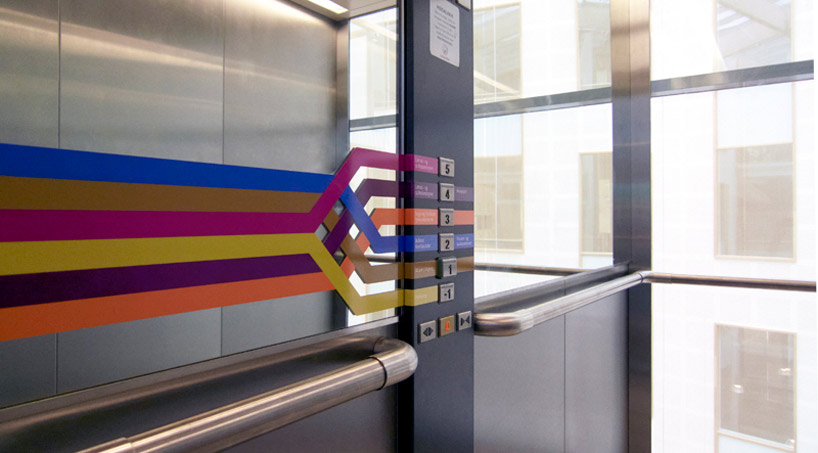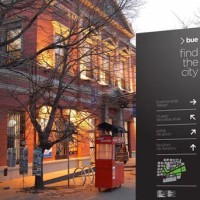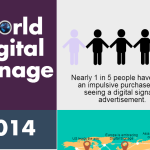
Signage is an advertising platform that relies on visual graphics to display information to an audience of any kind. Signage is an ancient advertising method used since as early as pre medieval times and it still continues to play a massive and evolving part in advertising today.
In the case of mobile and digital signage, these visual graphics can be created from neon tubes, LED lights, ordinary lighting and more recently from high resolution interactive visual screen displays
Let’s examine how signage in general but more specifically electronic signage have both evolved to meet the demands of more modern marketing trends.
Classical signage
Source: fatstickman.com
.jpg) Classical signage has evolved enormously over the centuries and even more quickly, more recently over the last few decades. Business marketing signs have gone from being simple advertising platforms and evolved into multicolored, highly innovative design platforms that allow companies to really showcase not just what they’re all about but also how creative and aesthetic they can be. The modern signs in the image above are an excellent example of just this, showing an sleek, futuristic design that itself sends a certain message about the advertiser; as much or more than the words and images on the signs themselves.
Classical signage has evolved enormously over the centuries and even more quickly, more recently over the last few decades. Business marketing signs have gone from being simple advertising platforms and evolved into multicolored, highly innovative design platforms that allow companies to really showcase not just what they’re all about but also how creative and aesthetic they can be. The modern signs in the image above are an excellent example of just this, showing an sleek, futuristic design that itself sends a certain message about the advertiser; as much or more than the words and images on the signs themselves.
In addition to display, color and materials innovations, many modern signs are also no longer so simple as rectangular, circular or two dimensional displays. Instead, many of them are made into odd shapes that can resemble either the products being promoted or all sorts of other things.
Yet another highly important trend has been innovation in terms of sign placement: many examples of modern signage will be placed in truly interesting and highly artistic displays that can cover entire buildings, sidewalks or city structures of all sorts. In many cases they will look downright graffiti-like in their appearance and this is exactly the point being made; the signs are built this way so that they call attention to their oddness, edginess and in-conformity with the surrounding landscape:
Source: partnershipactivation.com
These trends in signage design aren’t accidental or whimsical. They are the product of a carefully calculated marketing strategy whose basic aims are to capture as much as possible of the buying public’s increasingly scarce attention to any one thing in their urban environment.
Classical Signage Tips for your Business:
If your business is using ordinary signage (as opposed to digital signage, which we’ll get to shortly) then there are some basic best practices you need to implement for maximum results.
1. Work For Maximum Exposure: Since signs attract less marginal attention today than they had in earlier times, you need to compensate for this in as many ways as possible. The first of these is by making sure your sign is exposed to as many people as possible. Be it a billboard, series of lamp post ads or a well-placed series of street and vehicle signs, the bottom line is maximum eyeballs; with low conversions, to use internet marketing lingo, more viewers means more customers.
2. Design for your Target Audience: Again, since the key problem behind signage in the modern urban world is getting attention, every extra step that does so is a powerful bonus. In this case, pay careful attention to who you’re trying to sell to and design your signs for maximum appeal to that buyer’s mindset. Shock them, inform them or make them laugh out loud with what you say and how you present it, as long as you’re appealing to their tastes and interests.
3. Be Creative with Design: This a complex concept that doesn’t automatically mean more color or strange shapes –quite the contrary at times since even unexpected simplicity also calls its own attention. Essentially, by creative we mean that you should aim for sign designs that stand aside from the context in which they’re presented, grabbing more attention in the midst of the remaining advertising saturated urban environment.
Now we can move on to the latest innovations in digital signage and see where new rules and technology come into play and take things to a whole new level.
The Arrival and Evolution of Digital Signage
 Digital signage represents the logical outcome of the above-mentioned points involving attention retention in consumers.
Digital signage represents the logical outcome of the above-mentioned points involving attention retention in consumers.
Its digital layout, interactive nature and ability to cram much larger amounts of multifaceted information into a single advertising space make it the logical solution to a major marketing trend in the direction of sticking out as much as possible from the clutter of competition.
To quickly define it; digital signage basically consists of any interactive, mobile and electronic display of advertisements, menus, sales promotions or nearly any kind of information within a single display space and under conditions that allow for multiple images and graphics to appear in sequence. (Source. digitalsignagetoday.com)
Companies all over the world have been using the more basic forms of this technology (LED displays and projected images) for more than a couple of decades. But, todays new developments in flat screen technology, LCD displays and plasma screens; as well as developments in interactive digital rendering and miniaturized computing power, have all led to a massive proliferation of digital signage displays in places ranging from stores to airports to streets and even to public transportation like buses and subway trains.
Source: avactions.com
More impressive still is the development in signage that is one-on-one interactive in the sense that it can respond to requests for more information when a viewer touches the screen and also even hand over information that can be wirelessly downloaded right to that users smart phone or other electronic device.
This sort of technology could be called “intelligent signage” and represents that latest in the already relatively new field of digital signs. (Source: Comqi.com)
Again, with all of these trends, what we’re seeing is the need of marketing companies pushing innovation in ways that try to maximize viewer attention in a landscape saturated by advertising of all types. With digital signage, this has become possible to an extent never seen before in the field of sign based advertising. Furthermore, the capacity of many digital signs to actually present multiple information displays in sequence on a single screen has also allowed for signs that don’t just advertise but also inform people in useful ways with up to the minute detail, thus giving more incentive for consumers to pay attention.
Digital & Smart Signage Tips for your Business
1. Be Creative with your Signage: The nature of this new medium gives you access to much more dynamic visual presentations and information flow, take as much advantage of it as you can and avoid the trap of thinking in terms of classical signs. Instead, creatively arrange frames of information etc. so that they maximize the impact and visual appeal of what you’re advertising to your audience.
2. Aim for Captive Audiences: If you can, have intelligent display screens installed in places where people have to spend a certain amount of time waiting for something. Their “captivity” will dramatically increase the odds that they not only notice your signage but also start to pay serious attention to it. These sorts of spaces are often rented at a premium but clever searching can locate less obvious spots like bus terminals, Hotel Lounges and even bathrooms.
3. Give Viewers a Motivation to Watch: Don’t just sell to your audience! Digital signage is an interactive medium with enormous flexibility, you can use it to give much more dynamic information flow, videos and multimedia content. Take advantage of this by creating narratives that grab attention and give reasons for people to keep paying attention.
4. Split Test your Signage: Again, with digital signage you’re working through a electronic display medium that allows all sorts of cheap and very easy changes for the most part. Just like in any marketing campaign where you’re able to, test this medium as thoroughly as possible by creating multiple ads and seeing which show more effectiveness at attention capture and audience response. As any marketer can tell you, frequent testing is a hallmark of sound selling campaigns and signage permits this testing wonderfully.
Stephan Jukic is a freelance writer who generally covers a variety of subjects relating to the latest changes in white hat SEO, marketing, marketing tech and brand promotion. He also loves to read and write about subjects as varied as the idea of a location-free business, portable business management,and strategic marketing and advertising tactics. He also likes reviewing sites like Optiva, which specialize in SpellBrite LED signs. When he’s not busy writing or consulting, he spends his days enjoying life’s adventures either in Canada or Mexico. Connect with Stephan on Google+ and LinkedIn.















